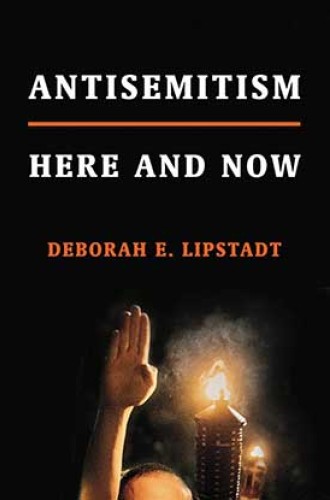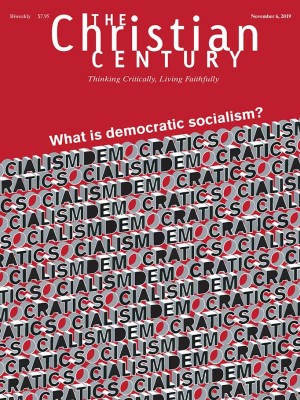The many varieties of anti-Semitism
Deborah Lipstadt shows how anti-Semitic sentiment can spring up where we least expect it.
Just a short drive from the site of the Auschwitz death camps, Polish shopkeepers sell trinkets bearing the image of a money-counting Jew—a stock image that could have come out of the Nazi era. In other parts of Europe, Jews and Jewish institutions have been violently attacked and Jews have taken to covering their heads with baseball caps rather than kippahs to avoid being identified. Meanwhile, in the US, the past 12 months have been the bloodiest ever for Jews: attacks on two synagogues by white nationalists left 12 people dead. According to the FBI, assaults against Jews are the most frequent kind of religion-based hate crime. Anti-Semitism is not only alive and well “here and now,” as Deborah E. Lipstadt puts it, it seems to be on steroids.
Just as alarming and puzzling as the persistence of anti-Semitism is its protean nature. Anti-Semitism surfaces among professors as well as street thugs, in sophisticated ideologies as well as crude stereotypes, and on the political left as well as on the right. It was expressed by the neo-Nazis in Charlottesville in 2017, who chanted “Jews will not replace us,” but also by the organizers of the 2017 Dyke March in Chicago, who prohibited participants from displaying (in rainbow colors) the Star of David because of its association with what organizers deemed a uniquely objectionable country—Israel. Anti-Semitism was featured in a tweet by Democratic representative Ilhan Omar, who echoed anti-Semitic tropes about Jewish avarice when she complained that political support for Israel is “all about the Benjamins” (a reference to $100 bills). It also appeared in a tweet by Donald Trump, who during his presidential campaign adopted an old conspiracy theory about Jews manipulating the global economy and insinuated that Hillary Clinton was the tool of Jewish financiers.
Read our latest issue or browse back issues.
Lipstadt, a professor of Jewish history and Holocaust studies at Emory University, offers an informal field guide to the varieties of contemporary anti-Semitism. The book is organized as a series of exchanges between herself and two fictional correspondents—Abigail, a Jewish college student, and Joe, a non-Jewish faculty colleague—who are alarmed and puzzled by the hostile attitudes toward Jews and Israel that they encounter on campus. The two imagined correspondents never become a forceful presence in the book, so the device is mainly a vehicle for Lipstadt to take up, rather unsystematically, her list of concerns. But the format does give the book an engaging, conversational tone.
Lipstadt begins with a definition:
Imagine that someone has done something you find objectionable. You may legitimately resent this person because of his or her actions or attitudes. But if you resent him even an iota more because the person is Jewish, that is antisemitism. . . . Complaining about a “crooked real-estate developer” is one thing. Complaining about that “crooked Jewish real estate developer” is antisemitism.
Anti-Semitism starts with that irrational “iota more” of resentment toward Jews simply because they are Jews. Or—as becomes clear as the book goes on—an iota more of resentment toward Israel simply because it is a Jewish state.
Lipstadt’s taxonomy of anti-Semitism includes “dinner party” bigots, Islamist extremists, and Holocaust deniers. The latter topic is a specialty of Lipstadt’s: she is the author of Denying the Holocaust, and in the 1990s she was sued by writer David Irving, who said Lipstadt had defamed him when she termed him a Holocaust denier. (She won the libel case by demonstrating to the judge how Irving had distorted the historical record.) Holocaust denial is a peculiar species of anti-Semitism—the kind that masquerades as historical inquiry.
Lipstadt gives less space to Holocaust deniers, neo-Nazis, and other blatant anti-Semites like David Duke and Richard Spencer than to what she calls the “enablers” of hate. Her chief examples are President Trump and British Labour Party leader Jeremy Corbyn. The fact that Trump has a Jewish son-in-law and has been an ardent supporter of Israel’s right-wing government in no way lessens his culpability in Lipstadt’s eyes. Besides exploiting the notion that Jews dominate world finance, Trump has accepted support from figures like Duke and Spencer and refused to condemn them even when explicitly invited to do so. He insisted that “good people” were part of the neo-Nazi rally in Charlottesville. His presidential campaign collaborated in harassing Jewish journalists. It used social media to court the support of white supremacists. Trump may not hate Jews, but he finds other people’s hatred of Jews politically useful, which Lipstadt judges to be just as dangerous and perhaps more so, since it injects extremism into the mainstream culture. “Enabling anti-Semitic acts is itself an anti-Semitic act that causes as much damage as something from an ideological anti-Semite.”
Corbyn too has implicitly endorsed people who demonize Jews. His circle has included former Church of England vicar Stephen Sizer, who claimed that Jews and Israel were responsible for the 9/11 attacks and accused Jews in Israel of murdering Palestinian children for sport. Corbyn defended Sizer by saying that the vicar had the courage “to speak out against Zionism.” Corbyn has termed members of the anti-Israel terrorist groups Hamas and Hezbollah his “friends” and invited them to meet with him in Parliament. On one Holocaust Remembrance Day, he hosted an “Auschwitz to Gaza” event that compared Israeli leaders to Nazis. Lipstadt devotes 12 pages to recounting the ways that Corbyn and others in the Labour Party have consorted with or refused to condemn anti-Semitism. Again, the issue is not whether Corbyn and colleagues personally hate Jews; it’s that their actions and inactions encourage attacks on Jews and on Israel.
The pairing of Trump and Corbyn underscores one of Lipstadt’s major concerns: anti-Semitism infects both the political left and the political right. Each side, she worries, tends to condemn the version exhibited by its opponents while ignoring or denying the type that flourishes in its own ranks.
Corbyn’s anti-Semitism differs from Trump’s in one respect, however. Whereas Trump’s is a form of political opportunism, Corbyn’s is ideologically tied to a critique of Israel for its treatment of Palestinians. Corbyn views Israel and the Zionist movement that created Israel (and that supports its existence) as a systematic denier of Palestinian rights. He befriends the enemies of Israel because he thinks they are on the right side of the liberation struggle.
Nevertheless, in his simplistic, exaggerated views of Israel, and in his encouragement of Israel’s ardent enemies, Corbyn is part of what Lipstadt calls the “toxifying” of Israel. The book is checkered with accounts of Israel being treated as a pariah nation, especially on college campuses, where Israeli scholars have been disinvited or shouted down, Jews supportive of the state of Israel dismissed as apologists for fascism, and even Hillel groups shunned as politically suspect.
The campaign against Israel on the political left generates some striking ironies. For example, pro-LGBTQ groups on campus are often keen to align themselves with pro-Palestinian groups in what is posited as a joint struggle against oppression—despite the fact that Israel is far more hospitable to gay rights than are Palestinians or any other country in the Middle East.
Charging critics of Israel with anti-Semitism invites this question: What exactly makes a critique of Israel anti-Semitic? Obviously not every critique of Israeli policy is anti-Semitic, any more than every critique of United States policy is anti-American. One can criticize the policies of the state of Israel without being prejudiced against Jews; after all, Jews do it all the time.
Lipstadt doesn’t directly answer that question. She tends to assume that hyperbole and misinformation about Israel are obvious, and that these are clear markers of anti-Semitism. I suspect that not all her readers would make the same judgments or assumptions. At one point she offers Abigail and Joe this strategy for engaging critics of Israel:
There is nothing wrong in acknowledging that the current situation in the West Bank is untenable, and in explaining that the most reasonable solution would be two states—a Jewish state and a Palestinian state—side by side, with secure and defensible borders. This idea will be rejected by those who deny the legitimacy of a Jewish state anywhere in Mandatory Palestine or those who claim that Israel will never be a good faith negotiator. Discussing anything with them is, indeed, pointless. At the same time, we must carefully distinguish between campaigns that disagree with Israeli policy and those that essentially call for the elimination of a Jewish state.
Those ground rules seem clear enough: disagreement about policy is fine as long as it doesn’t aim at the elimination of Israel.
In practice, however, this distinction tends to dissolve because a great many policy issues touch closely on the survival and security of Israel. This becomes clear in Lipstadt’s own discussion of the boycott, divestment, and sanctions movement against Israel. For many supporters of BDS (including many mainline Protestants), the campaign concerns policy: it is a strategy not for eliminating Israel but for pressuring Israel into changing its policies toward Palestinians and thereby fostering more peace and justice in the region. BDS supporters would reject the charge of anti-Semitism; they are opposing Israeli policy, not opposing Jews or the existence of Israel.
Lipstadt allows that supporters of BDS can sincerely (if naively) believe that BDS will foster peace and justice, and she agrees that they are not necessarily anti-Semitic. But she has no doubt that BDS founder Omar Barghouti is anti-Semitic—he is on record opposing a Jewish state in any part of Palestine—or that the ultimate goal of the movement is to delegitimize and then eliminate Israel. So while BDS supporters may not realize it, she says, their effort to weaken Israel by imposing economic and political sanctions is aligned with those who want to see Israel disappear.
It’s axiomatic for Lipstadt, as it is for most Jews, that support for a one-state solution to the Israeli-Palestinian conflict—which would result in Jews being a minority within a nation made up mostly of Palestinians—is essentially a call for the dissolution of Israel. (The same would hold for any two-state solution that grants Palestinians an unlimited right to return to former homes in Israel.) After all, the whole purpose of Zionism was to create a nation where Jews could be safe and freely live out their national identity.
It’s also axiomatic for Lipstadt that to work for the dissolution of Israel is by definition anti-Semitic. Such work can be fueled only by an irrational resentment that a Jewish state exists. For how can anyone champion a state for Palestinians or any other national group in which a people can live out their particular national identity without at the same time championing one in which Jews can do the same? Lipstadt’s answer is clear: only by being anti-Semitic.
Critics of Israel are often frustrated by the way discussions of Israel can turn quickly to charges or implications of anti-Semitism. Israel’s defenders seem, to many of its critics, to deploy the charge as an unfair rhetorical weapon. Lipstadt actually agrees to some extent. “Those of us who want to fight this scourge do ourselves no favor if we automatically brand ideas with which we disagree as ‘antisemitic.’ Too often some Jewish organizations and their leaders reflexively fall back on this accusation.” Lipstadt’s position is not that all critiques of Israel are anti-Semitic. It’s that an alarming number of them are.
In discussing Israel, it’s hard to draw a sharp line between judgments about discrete policies and judgments about Israel and the Zionist project as a whole. There is no way to avoid diving into the details of history and political decision making, including the conditions that gave rise to Zionism, the political and military events that led to the formation of Israel in 1948, the circumstances under which Israel acquired the West Bank and Gaza in 1967, the history of conflict and negotiations between Israelis and Palestinians, and the local and regional security concerns that have shaped Israeli politics. These discussions involve a history in which every story has many angles and few individuals have unstained hands or pure motives.
The essential question for most Jews and for Lipstadt, I take it, is whether an account of this history and the current situation is reasonably balanced, informed about the Jewish experience, and sympathetic to Jews’ quest for nationhood. Those who don’t even attempt to be balanced or informed, or who think Israel should never have been created or that its disappearance would be no great tragedy, are understandably suspected of anti-Semitism—suspected, to use Lipstadt’s definition, of harboring more than “an iota more” of resentment toward Israel simply because it is a Jewish country.
The charged debate over anti-Semitism is actually not so different from debates over racism in the US. When charged with being racist, many whites reject the charge out of hand and accuse those who raise it of muddling the debate. These whites might argue that their political positions merely express a stance on policy and have nothing to do with race. Surely, they might say, it’s possible to debate voter registration laws, or the criminal justice system, or the funding of urban education quite apart from issues of race.
But of course it’s not. Current debates in American politics can’t be disentangled from the nation’s racialized history and attempts either to ignore or reform it. In a similar way, debates about Israel can’t be disentangled from the historic—and current—precariousness of Jewish life and the ways that Israel has offered Jews a solution to it. In each case, those who disregard the effects of history—and dismiss the views of those who have suffered it—are rightly suspected of callous indifference or prejudice.
Among the more bizarre brands of current anti-Semitism is the phenomenon of people who hate Jews but love Israel, as in the case of Hungary’s prime minister Viktor Orbán. He has galvanized nationalist sentiment by fomenting fears of immigrants, and in that context he has revived the idea that Jews are especially dangerous aliens. In a classic anti-Semitic gambit, he portrays businessman George Soros as part of a global Jewish threat to Hungarian values. At the same time, he has sought closer ties with Israel’s prime minister Benjamin Netanyahu on the theory that strong nationalist leaders need to stick together. Netanyahu has reciprocated and made similar connections with ethno-nationalist leaders in Poland, Slovakia, and the Czech Republic. President Trump fits into the same company.
Lipstadt is worried about the resurgence of anti-Semitism in Central Europe, but she is also appalled by the version of realpolitik that leads Netanyahu to consort with anti-Semites and Holocaust revisionists. His actions make her “question Netanyahu’s claim that Israel is the primary protector of Jews worldwide against antisemitism and persecution.” Given Lipstadt’s commitments, one can hardly think of a more severe criticism of Israeli policy.
As she tracks the varieties of anti-Semitism, Lipstadt occasionally pauses to check herself: she doesn’t want to be a Jew who sees anti-Semitism everywhere or who exaggerates the threats. She is well aware that prejudice against Jews and Israel is not as insidious or threatening as prejudice against African Americans, and she recognizes that by comparison Jews in the US enjoy considerable privilege. She wants to be vigilant against the forces of anti-Semitism without making her entire life one of defensiveness and victimhood—which would be a betrayal of the riches of Jewish identity. She doesn’t want her fight against what is sometimes called the world’s “longest hatred” to define her identity or that of her students.
Poignantly, she wonders at times if her career of vigilance is all for naught. If anti-Semitism is fundamentally irrational, can one ever defeat it by means of rational argument? But she doesn’t linger with that thought. Like all informed, responsible people, she has no alternative but to try.
A version of this article appears in the print edition under the title “Who counts as an anti-Semite?”







